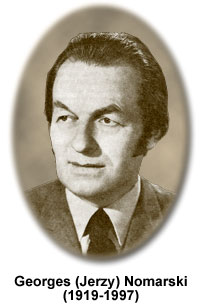Georges (Jerzy) Nomarski
(1919-1997)

A Polish born physicist and optics theoretician, Georges Nomarski adopted France as his home after World War II. He is credited with numerous inventions and patents, including a major contribution to the well-known differential interference contrast (DIC) microscopy technique. Also referred to as Nomarski interference contrast (NIC), the method is widely used to study live biological specimens and unstained tissues.
Nomarski was born on January 6, 1919 in the city of Nowy Targ (Poland) and began his education in Warsaw, but served in the Polish Resistance during World War II. He was captured by enemy forces and was a prisoner of war until March 1945. Afterwards, Nomarski immigrated to Belgium as a political refugee. He studied there briefly before he, like another famous Polish physicist, Marie Curie, chose France for his permanent residence in 1947. He finished his education and received his diploma from l'Ecole Supérieure d'Optique Paris (Grande Ecole). In 1950, Nomarski established the Laboratoire de Microscopie Optique de L'Institut d'Optique and became a professor of microscopy and head of the department at his alma mater. He simultaneously conducted research at the Centre National de la Recherche Scientifique (CNRS), where the physicist rose to the Directorship of Research by 1965. Nomarski retired near Paris in Anthony, France in the late 1980s. Although he died in 1997, his work lives on.
Nomarski received several honors and awards during his lifetime. He was named a fellow of the Optical Society of America in 1972 and later awarded the title of Honorary Fellow by the Royal Microscopical Society. He was also a recipient of the Abbe Medal, an award originated by the State Microscopical Society of Illinois to celebrate the 100th anniversary of Abbe's theory of microscopic image formation. In 1995, Nomarski was presented with the Gold Medal by the International Society for Optical Engineering, their highest honor.
The modifications Nomarski made to the Wollaston prism during the 1950s are still of significant consequence. Following in the footsteps of Frits Zernicke's milestone phase contrast microscopy breakthrough, Nomarski improved the method for detecting optical gradients in transparent specimens and converting them into intensity differences. The applications of his design, which are collectively referred to as differential interference contrast (DIC), are most important in cell biology and in examination of surface textures in the materials sciences. Some of the most pertinent features of the DIC microscopy method include directional sensitivity, effective optical sectioning, control of contrast, and the shadow-cast effect of images. In the modern scientific world, Nomarski interference microscopes continue to flourish in both transmitted (diascopic) and reflected (episcopic) light versions.
Differential Interference Contrast Microscopy - An excellent mechanism for rendering contrast in transparent specimens, differential interference contrast (DIC) microscopy is a beam-shearing interference system in which the reference beam is sheared by a minuscule amount, generally somewhat less than the diameter of an Airy disk. The technique produces a monochromatic shadow-cast image that effectively displays the gradient of optical paths for both high and low spatial frequencies present in the specimen. Those regions of the specimen where the optical paths increase along a reference direction appear brighter (or darker), while regions where the path differences decrease appear in reverse contrast. As the gradient of optical path difference grows steeper, image contrast is dramatically increased.
Wavefront Shear in Wollaston and Nomarski Prisms - A Wollaston prism is composed of two geometrically identical wedges of quartz or calcite (which are birefringent, or doubly-refracting materials) cut in a way that their optical axes are oriented perpendicular when they are cemented together to form the prism. If a linear polarizer is oriented so that plane-polarized light enters the prism at a 45-degree angle with respect to the optical axes of the two birefringent prism halves, the light is sheared into two plane-polarized components that are oriented mutually perpendicular to each other. This interactive tutorial examines differences between the location of the interference plane in Wollaston and Nomarski prisms, and how the position of the plane can be varied with changes to the optical axis orientation in a single prism wedge.
